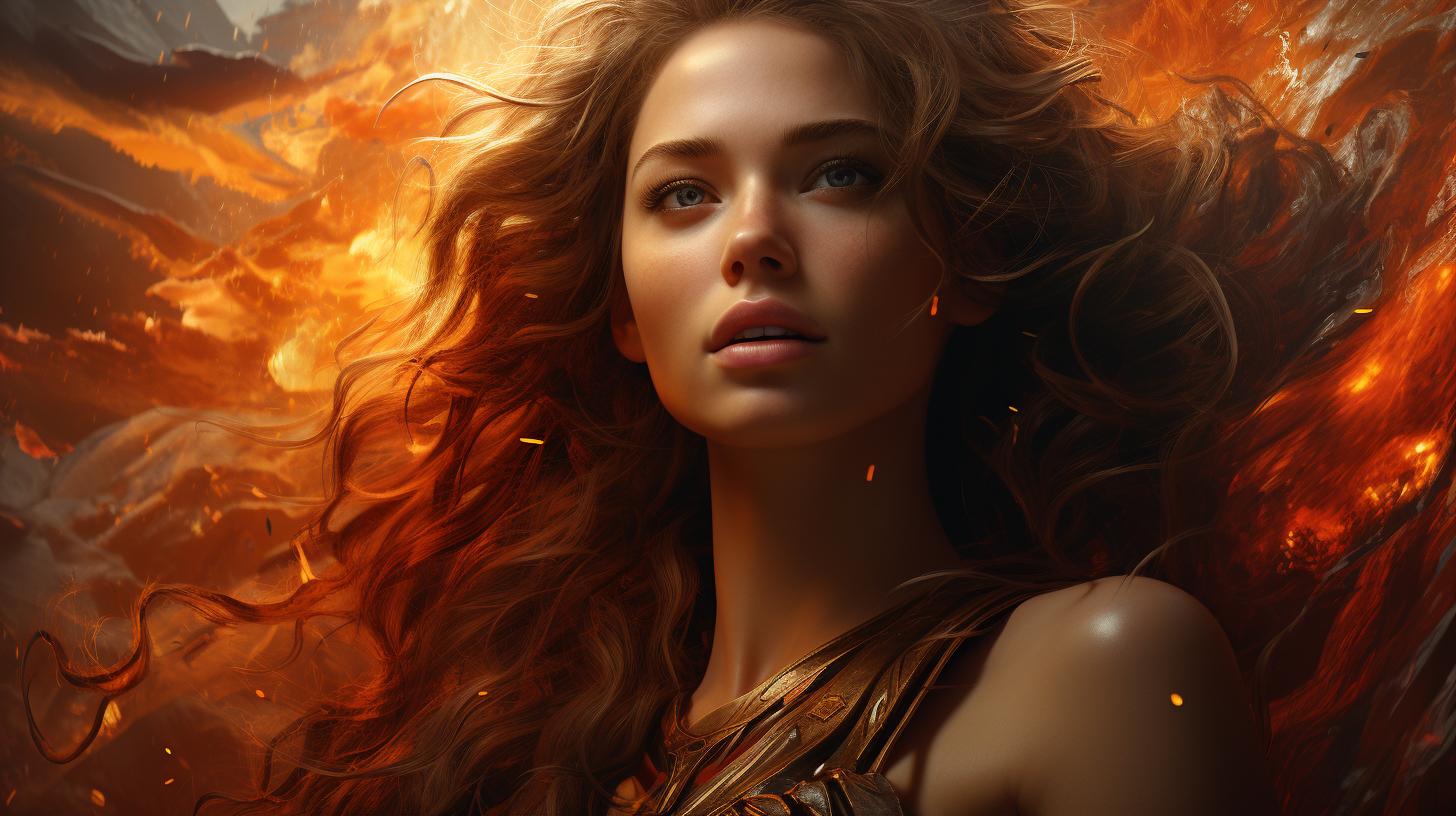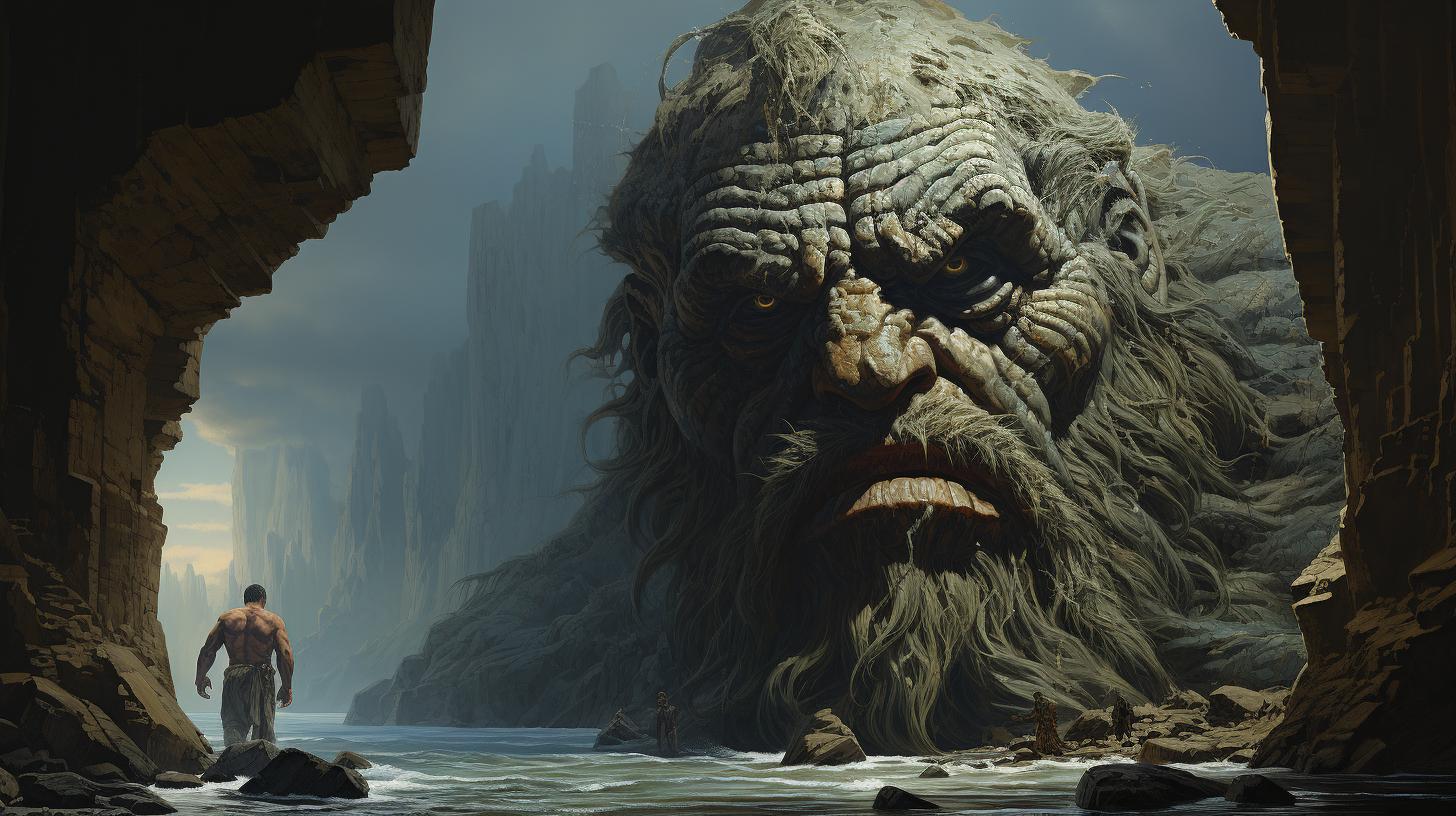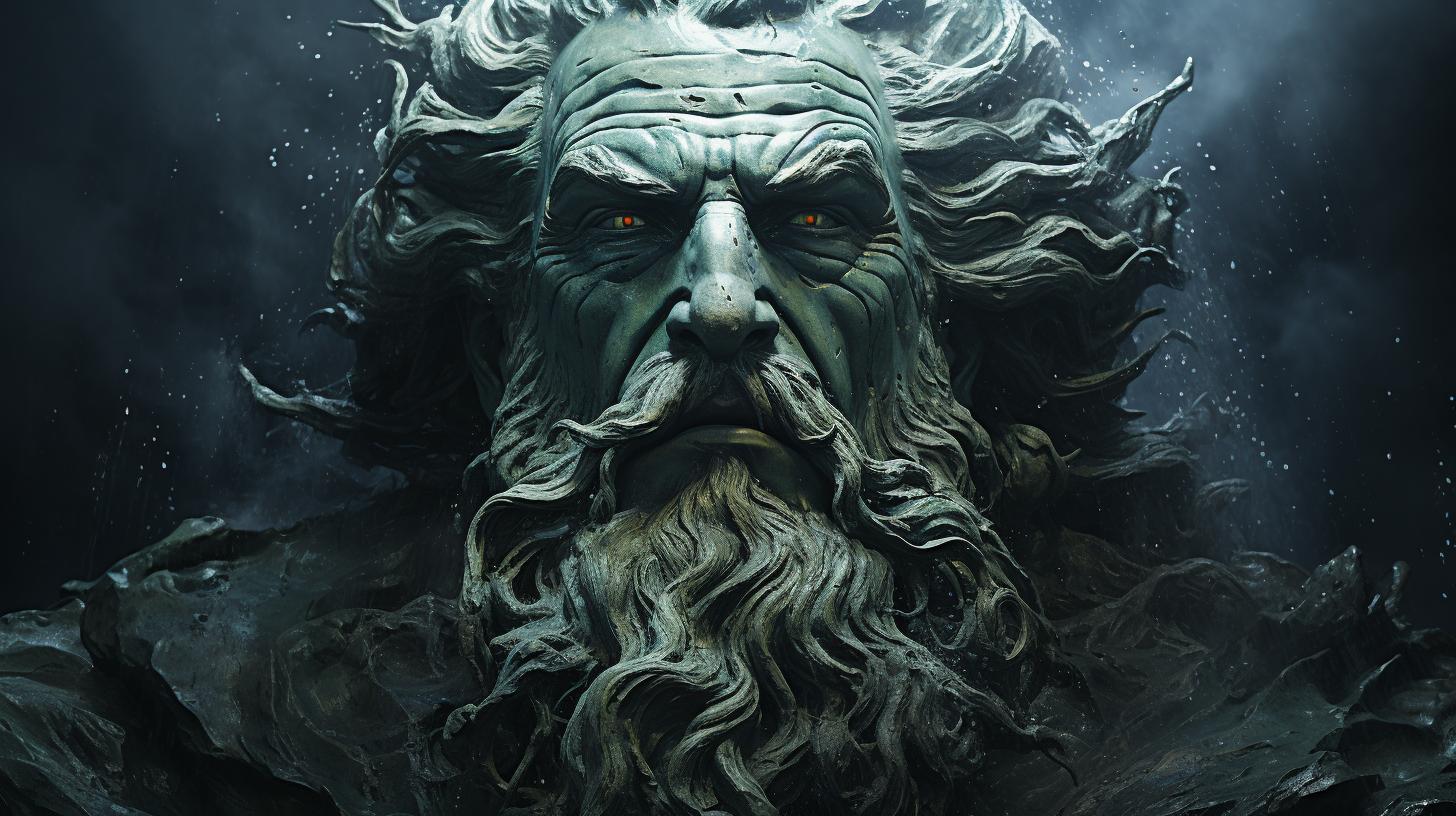Understanding Pyrrha in Greek Mythology

Pyrrha, a notable figure in Greek mythology, played a crucial role in the repopulation of the earth after a devastating flood. Alongside her husband Deucalion, they were the sole survivors.
Pyrrha’s significance lies in her lineage, as all Greek women can trace their ancestry back to her. This article explores Pyrrha’s role, the myth of the flood, her family heritage, and the lasting legacy she left on Greek culture and beliefs.
Understanding Pyrrha in Greek Mythology
Pyrrha holds a significant place in Greek mythology due to her pivotal role in the repopulation of the Earth after a devastating flood. Alongside her husband, Deucalion, Pyrrha emerged as one of the only survivors of this cataclysmic event, becoming the progenitors of the new human race.
Pyrrha’s lineage can be traced back to her parents, Epimetheus and Pandora, who bestowed upon her the name derived from the Greek word ‘purrhos’, signifying her fiery red hair. Unlike her mother, known for releasing miseries and diseases into the world, Pyrrha’s legacy was vastly different.
As per Greek mythology, every Greek woman can directly attribute their lineage to her.
The story of Pyrrha and Deucalion mirrors the biblical narrative of Noah and the Ark. Promethus, the Titan with the gift of foresight, warned Deucalion about Zeus’ plan and advised him to construct an ark to survive.
Once the floodwaters receded, the couple landed on Mount Parnassus, finding themselves as the sole survivors. As advised by the oracle Themis, they sought a method to repopulate the Earth.
The oracle instructed them to throw the bones of their mother over their shoulders. Understanding the ‘mother’ as Gaia, the Earth Mother, and the ‘bones’ as rocks, they complied. Thus, Pyrrha and Deucalion transformed into men and women, respectively, by hurling the rocks over their shoulders.
In addition to repopulating the Earth through the rocks, Pyrrha and Deucalion had six children of their own, establishing the Hellenic race – the Greeks. Among their descendants was Helenus, who became the forebear of the Greek people.
Despite the various versions of Pyrrha’s story, they all concur that she and Deucalion survived the flood caused by Zeus, playing a vital role in the repopulation of the Earth.
Her tale endures as part of the rich legacy of Greek mythology, still captivating academic and enthusiastic minds alike, including the Reddit community at r/GreekMythology. With her fiery red hair and contribution to repopulation, Pyrrha left an indelible mark on the ancient Greek culture and belief system.
The Legend of Deucalion and Pyrrha
In Greek mythology, the story of Deucalion and Pyrrha revolves around their survival during a cataclysmic flood and their crucial role in repopulating the earth. Similar to the biblical tale of Noah and the Ark, Deucalion received a warning from the Titan Prometheus about Zeus’ plan to destroy humanity.
He advised Deucalion to build an ark to ensure their survival.
After the floodwaters receded, Deucalion and Pyrrha found themselves as the sole survivors, landing on Mount Parnassus. Their task was to restore the human race.
Seeking guidance, they consulted the oracle Themis. The oracle instructed them to throw the bones of their mother over their shoulders, which represented the Earth, in order to bring forth new life.
Interpreting “bones” as rocks, they followed the oracle’s advice and threw stones behind them. Remarkably, the stones transformed into men and women, paving the way for the repopulation of the world.
In addition to this miraculous event, Deucalion and Pyrrha also had six children of their own, becoming the progenitors of the Hellenic race, the Greeks.
The tale of Deucalion and Pyrrha showcases the resilience and resourcefulness of humanity in the face of catastrophe.
It highlights the power of oracles and the profound impact that their actions had on shaping the future of Greek civilization. This legend, passed down through generations, continues to captivate and inspire individuals to this day.
Exploring the Greek Flood Myth
The Greek flood myth, featuring Pyrrha and Deucalion, holds significant parallels to the biblical story of Noah and the Ark. According to the legend, Prometeus, a titan gifted with foresight, warned Deucalion about Zeus’ plan to destroy humanity through a great flood.
Inspired by Prometeus’ warning, Deucalion constructed an ark to save himself and his wife, Pyrrha. As the cataclysmic floodwaters ravaged the earth, the couple sought refuge within the ark, braving the turbulent waters for days until finally, they found themselves stranded on the peak of Mount Parnassus when the floodwaters receded.
The survival of Pyrrha and Deucalion was a remarkable feat, underscoring their resilience in the face of divine wrath. Their tale highlights the theme of catastrophic rebirth, as they symbolically represent the hope of a new beginning for humankind.
Examining the Greek flood myth offers insights into the ancient Greeks’ understanding of the power of deities and their capacity to reshape the world. It portrays the consequences of divine judgment and the endurance of the human spirit.
Pyrrha’s Family: Epimetheus and Pandora
Pyrrha, a key figure in Greek mythology, was the daughter of Epimetheus and Pandora. While her mother, Pandora, is infamous for releasing evils and diseases into the world, Pyrrha’s legacy was far different.
Her name, derived from the Greek word ‘purrhos’, meaning “flame-colored” or “red,” alludes to her distinctive red hair. In Greek mythology, it is believed that all Greek women can trace their lineage directly back to Pyrrha.
Epimetheus, Pyrrha’s father, was a Titan and brother of the famed Prometheus. Unlike Prometheus, who possessed foreknowledge, Epimetheus was known for his hindsight. He foolishly accepted Pandora, the first woman created by the gods, as his wife, despite Prometheus’ warning not to accept any gifts from Zeus. This action led to the release of evils upon humanity.
Pandora, Pyrrha’s mother, was created by Zeus as a punishment to humanity for Prometheus’ theft of fire. She was bestowed with curious qualities and a box containing all the evils of the world.
Succumbing to her curiosity, Pandora opened the box, releasing suffering and plagues.
Pyrrha’s family history, filled with cautionary tales and consequences, serves as an intriguing backdrop to her own part in the mythological narrative.
From her fiery red hair to her ancestral connection to Greek women, Pyrrha’s lineage contributes to the rich tapestry of Greek mythology.
Unveiling the Role of Pyrrha in Repopulation
Pyrrha, as one of the survivors of the catastrophic flood in Greek mythology, played a pivotal role in the repopulation of the earth. Alongside her husband Deucalion, they faced the daunting task of rebuilding the human race and restoring civilization.
The couple sought guidance from the oracle Temis, who provided them with a unique solution. They were instructed to throw the bones of their mother over their shoulders to aid in the repopulation process.
Interpreting the ‘mother’ as Gaia, the primal Mother Earth, and the ‘bones’ as rocks, Pyrrha and Deucalion followed the oracle’s advice and cast stones behind them.
By this miraculous act, the stones thrown by Pyrrha transformed into women, while those thrown by Deucalion became men.
Thus, they became the progenitors of a new generation, repopulating the devastated earth. Their descendants would go on to shape the future of the Greek civilization.
Pyrrha’s contribution to the repopulation was not limited to the stones thrown.
She and Deucalion also had six children of their own, paving the way for the emergence of the Hellenic race, encompassing the lineage and heritage of the Greeks.
The story of Pyrrha and Deucalion’s efforts to revive humanity mirrors the biblical tale of Noah and the Ark.
Both stories portray the survival of only a few individuals who, by divine intervention and wise guidance, managed to rebuild society against all odds.
Pyrrha’s fiery-red hair, as indicated by her name derived from the Greek word ‘purrhos’ meaning ‘color of flame’ or ‘red,’ adds to her distinctive persona.
Her unique role in the repopulation process and her lineage played a crucial part in shaping Greek culture, beliefs, and the ancestry of all Greek women.
The Oracular Advice: Consulting Themis
As Pyrrha and Deucalion sought to repopulate the devastated land after the cataclysmic flood, they turned to the oracle Themis for guidance.
Themis, the Titaness of divine law and divine order, possessed great wisdom and foresight.
Seeking clarity on their mission to restore humanity, Pyrrha and Deucalion presented their predicament to Themis. With her profound knowledge, she provided them with a crucial piece of advice that would shape the future of the human race.
Themis instructed the couple to throw the bones of Pyrrha’s mother over their shoulders. While this guidance may seem perplexing at first glance, it held a hidden meaning linked to the preservation and renewal of life.
By correctly interpreting the ‘mother’ as Gaia, the Mother Earth, and the ‘bones’ as stones, Pyrrha and Deucalion followed Themis’ counsel and cast the stones over their shoulders. Miraculously, those stones transformed into men and women, breathing life back into the barren world.
This profound act of casting stones over their shoulders symbolized the reinvention and reemergence of humankind. It demonstrated the power of Themis’ oracular wisdom, which allowed Pyrrha and Deucalion to rebuild civilization from the remnants of their past existence.
By heeding the advice of Themis, Pyrrha and Deucalion fulfilled their role as the progenitors of the new human race, paving the way for the ancient Greeks and shaping the destiny of future generations.
Resolving the Mystery: Bones and the Repopulation
In the aftermath of the devastating flood, Pyrrha and Deucalion turned to the oracle Temis for guidance on how to repopulate the earth. Temis advised them to throw the bones of their mother over their shoulders, which would bring forth new life.
Interpreting the “mother” as Gaia, the Mother Earth, and the “bones” as rocks, Pyrrha and Deucalion followed the oracle’s instructions.
With each stone that Pyrrha and Deucalion cast, a human arose.
The rocks symbolized the rebirth of mankind, as the new beings emerged from the stones. Pyrrha and Deucalion watched in awe as the population started to grow, with men and women appearing from the boulders.
Thus, they became the progenitors not only of their own six children but also of the Hellenic race, the ancient Greeks.
- The miraculous repopulation through thrown rocks highlighted the resilience and determination of Pyrrha and Deucalion.
- They embraced their responsibility as the founders of a new era, ensuring the continuity of humanity.
- Through their actions, Pyrrha and Deucalion exemplified the strength of the human spirit to overcome adversity.
As their descendants thrived and multiplied, Pyrrha’s influence endured, shaping the Greek civilization for centuries to come.
Her fiery red hair, symbolizing her name “Pyrrha” meaning “color of flame,” became an iconic feature linked to her legacy in Greek mythology.
The Descendants of Pyrrha and Deucalion: The Hellenic Race
Pyrrha and Deucalion, the sole survivors of the catastrophic flood in Greek mythology, played a critical role in the repopulation of the earth.
Their resilience and determination allowed them to rebuild humanity from the ashes of destruction.
As the floodwaters receded, Pyrrha and Deucalion faced the daunting task of restoring the human race.
Seeking guidance from the oracle Temis, they received a perplexing instruction: to throw the bones of their mother over their shoulders. Interpreting “mother” as Gaia, the Earth, and “bones” as rocks, they obediently followed the oracle’s advice.
With each rock they cast, a new person emerged, forming the foundation of the Hellenic race.
- The descendants of Pyrrha and Deucalion multiplied and flourished, giving rise to a vibrant and influential civilization in ancient Greece.
- Their offspring included notable figures such as Heleno, who became the progenitor of the Greeks.
- The Hellenic race, characterized by their rich cultural heritage, myths, and contributions to art, literature, and philosophy, owe their existence to Pyrrha and Deucalion’s determination to rebuild.
The descendants of Pyrrha and Deucalion played a significant role in shaping Greek history, establishing city-states, and spreading Greek culture throughout the Mediterranean and beyond.
The enduring legacy of Pyrrha and Deucalion is a testament to their strength and resilience. Their story captures the indomitable spirit of the human race in the face of adversity, inspiring generations to come.
Comparing Pyrrha and Deucalion with Noah and the Ark
When examining the story of Pyrrha and Deucalion in Greek mythology, we can draw parallels with the biblical account of Noah and the Ark. Both tales involve a catastrophic flood that wipes out most of humanity, sparing only a chosen couple to repopulate the earth.
In the Greek myth, Prometheus, the Titan who possessed the gift of foresight, warns Deucalion of Zeus’ plan and advises him to build an ark to ensure their survival.
Similarly, in the biblical narrative, God reveals His intentions to Noah and instructs him to construct an ark to escape the impending flood.
Upon the receding of the waters, Pyrrha and Deucalion land on Mount Parnassus, just as Noah’s Ark rests on Mount Ararat.
Both couples are left as the sole survivors, and from there, they begin the task of repopulation.
Interestingly, both stories involve divine intervention and guidance in the aftermath of the flood.
Pyrrha and Deucalion seek the advice of the oracle Themis, who instructs them to throw the bones of their mother over their shoulders. They interpret “bones” as stones and “mother” as Mother Earth, and thus they cast the stones behind them, which miraculously transform into humans.
Noah, on the other hand, receives divine instructions directly from God, who instructs him to bring pairs of animals on board the ark to ensure the survival of different species.
While the details and contexts differ, the overarching theme of a chosen couple surviving a catastrophic flood remains consistent in both the Greek and biblical narratives.
These stories not only captivate our imagination but also provide insights into the cultural and religious beliefs of ancient civilizations.
The Significance of Pyrrha’s Hair Color in Mythology
In Greek mythology, Pyrrha’s hair color holds symbolic significance that adds depth to her character and highlights her unique role in the ancient stories.
The name Pyrrha, derived from the Greek word ‘purrhos’ meaning ‘color of flame’ or ‘red,’ refers to her distinct red hair.
This physical trait sets her apart from other figures in Greek mythology and contributes to her individuality.
In ancient Greek culture, the color red was often associated with passion, intensity, and fire.
Pyrrha’s fiery hair color embodies these qualities, symbolizing her spirited nature and fierce determination, which are prevalent throughout her story.
This vivid physical attribute also serves as a contrasting element to her mother, Pandora, who is known for releasing evils and diseases into the world.
Pyrrha’s hair color, unlike her mother’s actions, represents a positive legacy, emphasizing her role in the repopulation of the Earth following the devastating flood.
Moreover, Pyrrha’s red hair becomes a defining feature that resonates with the mythological lineage of Greek women.
According to Greek mythology, all Greek women can trace their ancestry back to Pyrrha, making her a significant matriarchal figure.
While symbolic in nature, Pyrrha’s hair color represents her unique character traits and her contribution to the lineage of Greek women.
It showcases her strength, resilience, and importance in the mythology and cultural beliefs of ancient Greece.
Tracing Greek Lineage: All Women’s Ancestry to Pyrrha
In Greek mythology, Pyrrha holds a significant place as the progenitor of all Greek women. Her lineage can be traced directly to every Greek woman throughout history. As the daughter of Epimetheus and Pandora, Pyrrha’s ancestry is deeply intertwined with the origins of humankind.
According to ancient Greek myths, Pyrrha’s role in repopulating the earth after the devastating flood was paramount. Alongside her husband Deucalion, they sought guidance from the oracle Temis. Following Temis’ advice, they threw rocks over their shoulders, symbolically representing the bones of their mother, Gaia. These rocks brought forth a new generation of humans, becoming the ancestors of the Hellenic race.
- Pyrrha’s direct descendants include influential figures in Greek history, such as Heleno, the progenitor of the Greeks.
- This direct lineage from Pyrrha showcases the foundational role she played in shaping the Greek society and its people.
- Her red hair, symbolizing her name meaning ‘color of flame’, adds an intriguing element to the narrative, possibly reflecting her fiery spirit and distinctive presence in Greek mythology.
The belief that all Greek women can trace their ancestry back to Pyrrha underscores her enduring legacy.
Throughout generations, this lineage symbolizes a connection to the ancient past, honoring the roots of Greek heritage and culture.
One cannot underestimate the cultural significance of Pyrrha’s lineage in Greek mythology.
It highlights the importance of ancestry and the reverence bestowed upon mythical figures in shaping the identities and understanding of the Greek people. Pyrrha’s name and her role in repopulation stand as powerful symbols of ancient Greek heritage, transcending time and continuing to captivate the imagination.
Pyrrha’s Legacy in Greek Culture and Beliefs
Pyrrha, a central figure in Greek mythology, leaves a lasting impact on the culture and beliefs of ancient Greece. Her role in the repopulation of the earth after the catastrophic flood, as well as her familial lineage, have solidified her importance in Greek folklore.
Pyrrha’s red hair, symbolizing her name, ‘color of flame’ or ‘red,’ not only gave her a distinct physical appearance but also held symbolic significance. This fiery attribute embodied her connection to the powerful forces of nature and the divine.
The Progenitor of Greek Lineage
According to ancient Greek mythology, Pyrrha holds a significant place in the lineage of all Greek women. Every Greek woman can trace her ancestry directly back to Pyrrha, making her the ancestral mother of the entire Greek population.
Her descendants include prominent figures such as Heleno, who became the progenitor of the Greeks and played a pivotal role in shaping Greek history through the ages.
Influence on Greek Beliefs
The story of Pyrrha and her husband Deucalion surviving the flood and repopulating the earth became intertwined with Greek beliefs and cultural practices.
The resilience and resourcefulness demonstrated by Pyrrha and Deucalion served as a model for the Greek society, emphasizing the importance of endurance, family, and the preservation of life.
Pyrrha’s connection to Gaia, the Earth Mother, further reinforced her status as a divine figure.
Her role in the repopulation process, guided by the oracle Temis, highlighted the belief in the interdependence of humans and the natural world, as well as the importance of seeking guidance from the gods.
The myth of Pyrrha left a lasting impression on Greek artwork, literature, and religious practices. Her depiction in paintings and sculptures reflected her fiery spirit and her pivotal role as a mother figure, symbolizing fertility, birth, and the continuity of life.
Enduring Legacy
Pyrrha’s legacy continues to captivate the imagination and curiosity of scholars, historians, and enthusiasts alike. Through her tale, we delve into the rich tapestry of Greek mythology, exploring its intricate connections to history, culture, and the human experience.
As we navigate the complexities of the mythological world, Pyrrha stands as a testament to the enduring power of storytelling, serving as a reminder of the profound influence myths can have on shaping our understanding of the past and the present.
.




















